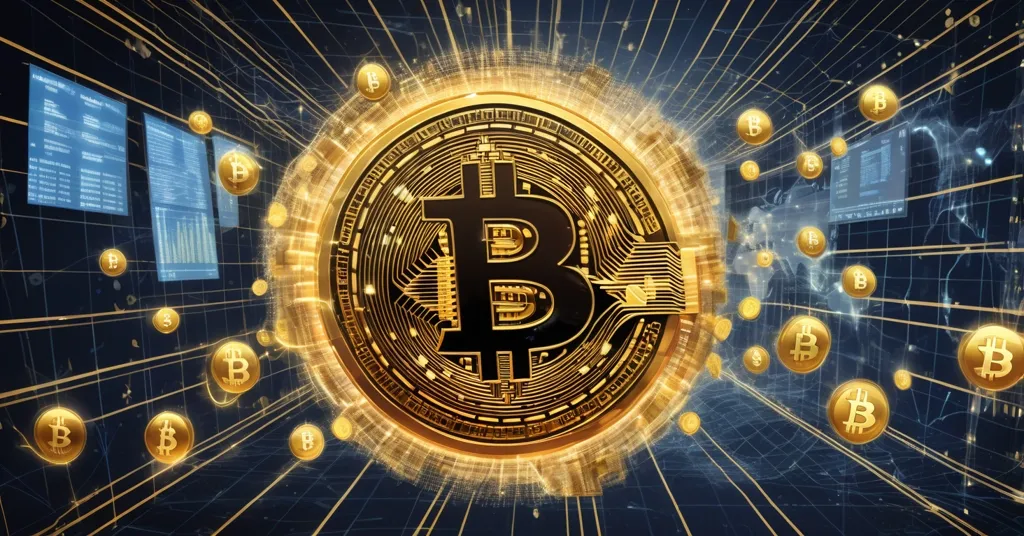Bitcoin Hits $108K Amid Fed Rate Cut and Germany’s Bold National Asset Push

Bitcoin Stalls at $108K: Fed Rate Cut Fuels Chaos as Germany Pushes BTC as National Asset
Bitcoin is teetering at $108,850, caught in a storm of volatility following the Federal Reserve’s recent rate cut, while global policy shifts and industry innovations add fuel to an already fiery crypto landscape. From Germany’s bold proposal to crown Bitcoin a national asset to miners pivoting to AI and new projects promising scalability, the space is buzzing with potential and peril. Let’s cut through the noise and unpack what’s really happening.
- Bitcoin’s Price Wobble: Holding at $108,850, showing bearish signals but clinging to the $108,900 support level.
- Fed’s Rate Slash: Dropped rates from 4.25% to 4.00%, shaking up markets with short-term uncertainty.
- Big Moves: Germany eyes Bitcoin as a national reserve, TeraWulf bets on AI, Binance fights for transparency, and Bitcoin Hyper emerges on Solana.
Market Snapshot: Bitcoin’s Balancing Act
Bitcoin’s current price of $108,850 has traders on edge, with the king of crypto showing a bearish tilt yet managing to hover just above a critical support level at $108,900. For those new to the game, a support level is a price point where buying interest historically kicks in to prevent further drops—think of it as a floor Bitcoin keeps bouncing on. This specific level ties to the 23.6% Fibonacci retracement, a technical tool based on the idea that prices often pull back a predictable chunk of a prior move before resuming a trend. If BTC slips below this floor, it could signal deeper losses; if it holds, a rebound might be in sight.
What’s rattling the cage? The U.S. Federal Reserve just slashed interest rates from 4.25% to 4.00%, aiming to boost economic growth but instead sending shockwaves through risk assets like Bitcoin. Lower rates typically mean more cash floating around for speculative plays, yet they can also stoke fears of inflation or signal economic weakness. Historically, post-2020 rate cuts saw Bitcoin rally over 300% in a year, but today’s lingering inflation concerns might cap any moonshot dreams. Right now, the market’s jittery, and BTC’s price action is as choppy as a stormy sea. Traders are glued to their screens, watching whether Bitcoin can muster the strength to push back or if it’s headed for a dive. For more on the market impact of the Fed’s decision, check out this detailed analysis of Bitcoin’s price volatility following the rate cut.
Global Policy Shifts: Germany’s Game-Changing Proposal
Across the Atlantic, a potential bombshell is brewing in Germany that could redefine Bitcoin’s place in the world. The largest opposition party, Alternative for Germany (AfD), is championing a radical idea: classify Bitcoin as a national asset, akin to gold in state reserves. This isn’t just symbolic—they’re pushing for BTC to be treated separately from other cryptocurrencies under the EU’s Markets in Crypto-Assets (MiCA) framework, a regulatory rulebook that mandates licensing for exchanges and imposes strict stablecoin oversight. AfD’s plan includes lighter regulations, maintaining VAT exemptions, safeguarding self-custody rights (your ability to hold Bitcoin without third-party meddling), and preserving a 12-month tax exemption on profits for long-term holders.
If Germany—a financial titan—starts stacking sats alongside its bullion, it could be the institutional stamp of approval Bitcoin maximalists have long craved. This isn’t mere political theater; it signals a shift in perception from Bitcoin as a speculative gamble to a legitimate store of value. However, let’s play devil’s advocate: could this backfire? The EU might push back hard against such a maverick move, or worse, over-regulate self-custody under the guise of “consumer protection,” undermining the very freedoms Bitcoin stands for. And while whispers of crypto-friendly policies echo in France, details remain scarce—making this more of a European wildcard than a done deal. Still, the idea of a G7 nation embracing Bitcoin at this level is a middle finger to centralized control and worth watching closely.
Industry Trends: Bitcoin Miners Pivot to AI
What happens when Bitcoin miners ditch the blockchain for AI? TeraWulf, a major player in the mining game, is betting big on a surprising pivot, raising $500 million—potentially $575 million—through convertible notes to build an AI-focused data center in Abernathy, Texas. For clarity, convertible notes are debt tools that can later turn into company shares, a way to fundraise without immediately diluting ownership. This isn’t a whim; it’s a strategic leap into the exploding demand for GPU computing, with AI workloads projected to grow at a 30% compound annual rate through 2030, per industry estimates. Miners like TeraWulf, with access to cheap energy and beefy infrastructure, are uniquely positioned to cash in on this tech boom.
They’ve got the pedigree to pull it off, having secured a $3 billion financing round with Morgan Stanley and a $1.4 billion guarantee from Google via a $3.7 billion hosting deal with Fluidstack, a Google-backed outfit. But let’s be real: this shift stings for Bitcoin purists. Mining is the heartbeat of the network, securing transactions through sheer computational grit. Seeing firms stray from Satoshi’s vision to chase AI profits highlights a harsh truth—mining margins are tighter than ever with price swings and rising network difficulty. It’s like a farmer switching crops when the market for their staple tanks. Survival trumps ideology in a brutal market, but does this signal a broader exodus from Bitcoin’s core mission? Only time will tell.
Transparency in Crypto: Binance Plays Detective
Over at Binance, the world’s top crypto exchange, a new partnership with Bubblemaps is aiming to clean up crypto’s Wild West reputation. This blockchain analytics firm, known for exposing a $30 million MELANIA token scandal, is now integrating tools into Binance’s Web3 Wallet to help users spot insider trading and market manipulation. For the uninitiated, insider trading in crypto often sees devs or whales hype a token, spike the price, then dump their holdings on retail suckers—pure scum tactics that erode trust. Bubblemaps’ tech visualizes wallet connections to flag suspicious activity, a step toward accountability.
Let’s not kid ourselves—this won’t catch every crook. Past transparency efforts, like Chainalysis partnerships with exchanges, have nabbed some bad actors but often lag behind the ingenuity of scammers. Still, Binance’s move is a response to mounting scrutiny over exchange practices and a bid to rebuild trust in an industry too often seen as a grifter’s playground. For those of us rooting for mass adoption, cleaning up these shady corners is non-negotiable. But will it be enough to convince skeptics that crypto isn’t just a scam factory? Don’t hold your breath—progress, yes, but the battle’s far from won.
Innovation Spotlight: Bitcoin Hyper on Solana
Amid the chaos, innovation charges on with Bitcoin Hyper ($HYPER), a Layer 2 solution built on Solana that’s raising eyebrows and cash—over $25.1 million in presale at $0.013185 per token, audited by Consult for trust. Layer 2 solutions are like express lanes on a clogged highway, sitting atop a blockchain like Bitcoin to boost speed and cut costs for transactions. Bitcoin Hyper blends Bitcoin’s ironclad security with Solana’s blazing-fast processing—think thousands of transactions per second at pennies compared to Ethereum’s gas fees. The goal? Enable smart contracts and decentralized apps (dApps) that Bitcoin’s base layer isn’t built for, like microtransactions or complex DeFi protocols.
As a Bitcoin maximalist, I’ll admit this fills a gap—BTC is the ultimate decentralized fortress but clunky for everyday use. Yet, let’s not sip the Kool-Aid just yet. Solana’s had its share of network outages, raising red flags about reliability. Marrying Bitcoin’s ethos to a less battle-tested chain could introduce security trade-offs or dilute what makes BTC king. And with Layer 2 projects popping up like weeds, many promise the moon only to crash into obscurity. Bitcoin Hyper could be a bridge to broader adoption, or it might just be another shiny token in a crowded field. The $25.1 million presale is impressive, but execution is everything—stay skeptical.
Price Outlook: Technicals and Tough Talk
Back to Bitcoin’s price, the technicals offer a murky forecast. The Relative Strength Index (RSI), a momentum gauge on a 0-100 scale, sits near 31 for BTC—edging into oversold territory, where values below 30 often hint at a potential bounce as buyers step in. If Bitcoin can close above $110,700, a recovery to $112,200–$114,950 might unfold. But a break below $108,900 could drag it down to $106,100 or even $103,500. Let’s cut the crap: most “BTC to $1M by next week” predictions are pure shilling from clowns hawking their bags. Markets are a beast—macro shocks like inflation data or a sudden regulatory hammer can flip any chart analysis on its head. The Fed’s rate cut might juice risk assets long-term, but short-term uncertainty is king. Keep your stop-losses tight and don’t buy into hype—Bitcoin’s volatile nature demands cold, hard caution.
Key Takeaways and Burning Questions
- What’s driving Bitcoin’s volatility at $108,850?
The Federal Reserve’s rate cut from 4.25% to 4.00% has spooked markets with uncertainty, while technical levels like the $108,900 support add pressure points for traders. - Can Germany’s push for Bitcoin as a national asset shift perceptions?
It could legitimize Bitcoin institutionally, signaling it’s more than a speculative toy, though EU pushback or regulatory overreach might sour the deal. - Why are Bitcoin miners like TeraWulf chasing AI?
With mining profits squeezed by price dips and network difficulty, pivoting to AI leverages their infrastructure for a booming market, as seen with TeraWulf’s $500 million Texas data center play. - Does Binance’s Bubblemaps tie-up boost crypto trust?
It’s a step forward, offering tools to detect insider trading, but scams are tenacious—don’t expect a magic fix for the industry’s shady rep. - Is Bitcoin Hyper on Solana a real win for Bitcoin’s ecosystem?
Potentially, by merging BTC’s security with Solana’s speed for dApps, though Solana’s outage history and project saturation cast doubt on long-term impact.
Bitcoin at a Crossroads
Bitcoin and the broader crypto space stand at a pivotal moment. The volatility sparked by the Fed’s rate cut reminds us that BTC, for all its decentralized glory, isn’t immune to the whims of traditional finance. Yet, developments like Germany’s proposal to enshrine Bitcoin as a national asset scream potential for mainstream legitimacy, while industry shifts like TeraWulf’s AI gamble show the ecosystem adapting to survive. Efforts from Binance to clamp down on scams and innovations like Bitcoin Hyper on Solana highlight a hunger for progress amid persistent growing pains. As champions of decentralization, privacy, and disruption, we see the bumpy road ahead as part of the fight—Bitcoin remains a defiant stand against broken systems. Stay sharp, guard your keys, and keep pushing for a freer financial future.



